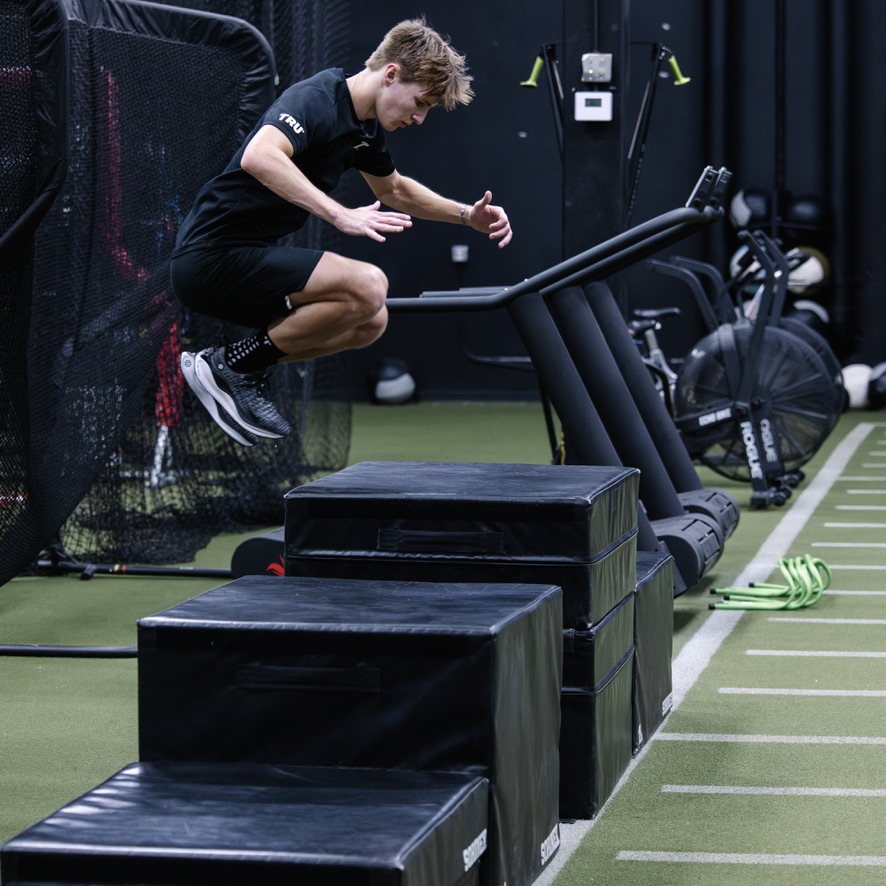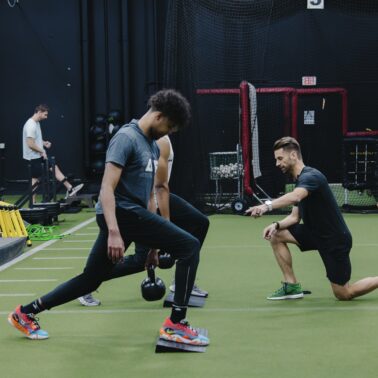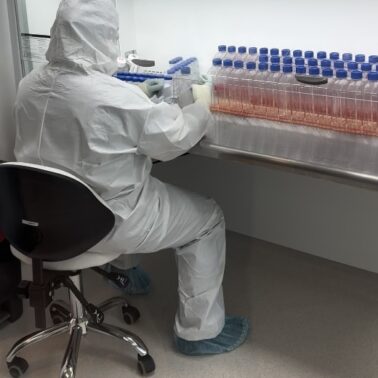Approximate Read Time: 9 minutes
“Force plate testing is easy and it provides hundreds of data points – the challenge is knowing what to measure and how to improve performance.”
What You Will Learn
- How to choose CMJ force plate metrics that actually matter.
- Which exercises best improve specific jump phases and metrics.
- How to integrate CMJ testing into the 3P Model for long-term performance.
Physiological Foundation
The countermovement jump (CMJ) is more than a jump —it’s a compact story of eccentric braking, isometric transfer, and concentric propulsion. Force plates capture this in great detail, breaking the jump into measurable phases including weighing, unweighting, braking, propulsion, flight, and landing (Berberet, 2024). Metrics like jump height (output), braking impulse (eccentric control), and modified reactive strength index (RSI-mod) describe how an athlete coordinates the stretch-shortening cycle.
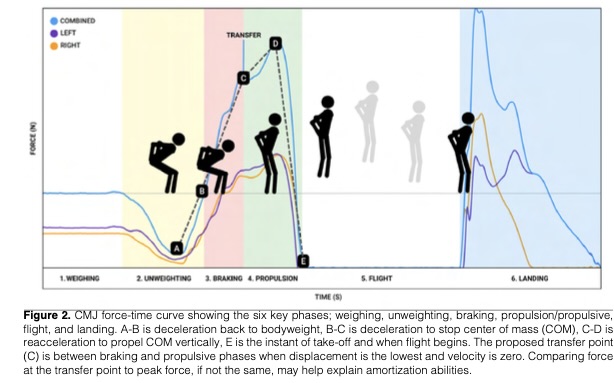
Principles of Adaptation
Training to improve CMJ metrics isn’t about chasing a higher jump number—it’s about targeting the physiological qualities that underpin it. Braking metrics connect to eccentric strength and deceleration, propulsive metrics to concentric power, and strategy metrics to neuromuscular coordination (Berberet, 2024).
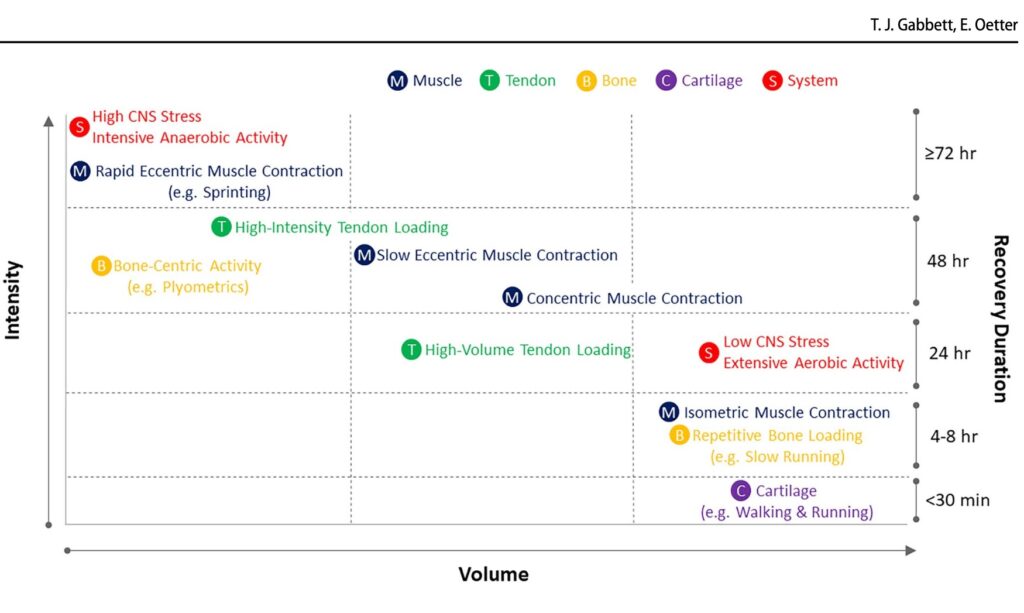
Adaptations, however, unfold on different clocks. Maximal strength gains—driven by neural recruitment early and structural changes later—typically require 6-8 weeks of consistent heavy loading to show meaningful changes. Hypertrophy, the growth of muscle cross-sectional area, is slower still, often emerging after 8 – 12 weeks and continuing across several months with sufficient volume and nutritional support. Speed and power qualities, especially those tied to neural efficiency and the stretch-shortening cycle, can show measurable improvements within 3–4 weeks of targeted plyometrics or velocity-based training, but require ongoing exposure to maintain.
Understanding these timelines is critical: when force plate metrics don’t change week-to-week, it doesn’t mean training has failed—it often reflects the biological pacing of adaptation. Practitioners must align the metric they care about with the reality of how fast the body can adapt.
Key Training Variables & Sample Exercises
- Eccentric overload: Nordic hamstring curls, tempo squats, and drop landings target braking metrics (Eccentric Peak Force, Eccentric Rate of Force Development)
- Concentric power: Olympic lifts, loaded jump squats, and resisted sprints improve propulsive metrics (PPF, PPP) (Weakley, 2020)
- Strategy & efficiency: Depth jumps, pogo hops, and RSI-mod drills sharpen neuromuscular timing and transfer (Bishop, 2021)
- Velocity-based training (VBT): Using bar speed thresholds can align loads with desired adaptations (Weakley, 2020)
Specific Examples
Basketball, soccer, and rehab all showcase the versatility of CMJ metrics, but in very different ways. In basketball, guards thrive when they can slam on the brakes—high relative braking force and sharper RSI-mod scores allow them to control short-space accelerations and beat defenders off the dribble (Berberet, 2024). Soccer forwards, by contrast, live in the air; higher propulsive force translates into winning aerial duels and powering through repeat jumps over ninety minutes.
“Jump height tells only part of the story—force plates reveal how athletes truly move.”
In return-to-play settings, such as post-ACL rehab, the spotlight shifts to asymmetry metrics, which give clinicians a sensitive lens into whether one leg is lagging behind despite normal jump heights (Bishop, 2021). Across all these settings, the lesson is the same: context dictates which CMJ metric truly matters.
Assessment Benchmarks
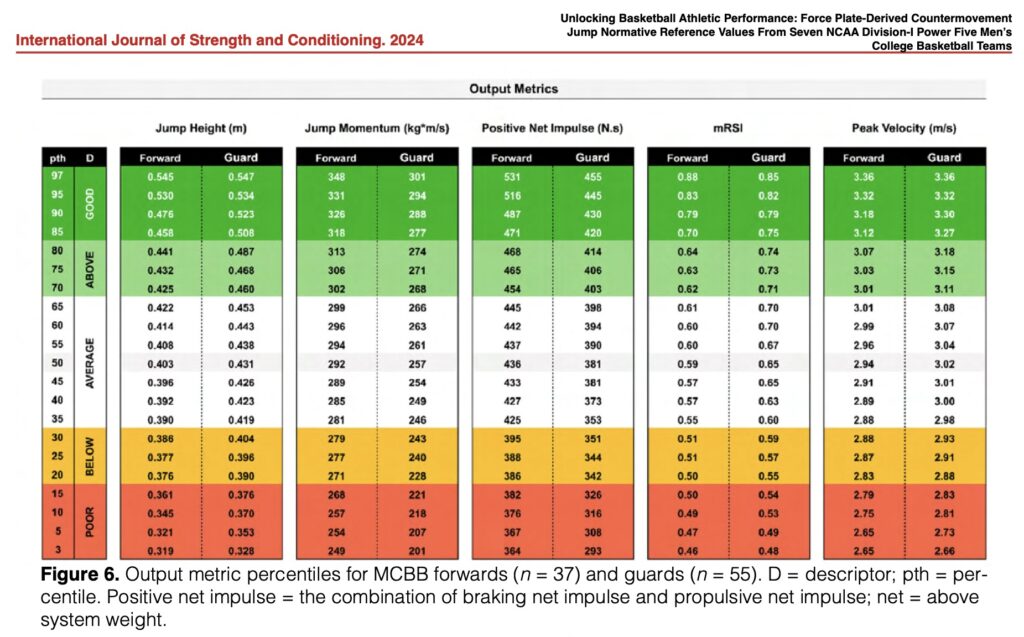
Recent NCAA Division I basketball data provides percentile norms for guards and forwards across metrics like jump height, braking force, and propulsive impulse2024. Force Plate-Derived Count…. This allows practitioners to anchor athlete profiles against meaningful reference ranges rather than arbitrary cutoffs.
3 Simple Progression Strategies
Force plate data makes it clear that no single metric stands alone—each has a developmental path. Peak force improves first with global strength lifts, eccentric braking metrics sharpen under targeted eccentric and concentric work, and finally RSI-mod comes alive once reactive plyometrics are layered on. Building training in this sequence ensures each key metric is trained in the order it naturally adapts.
- Start with global strength foundations using complex lifts (squats, deadlifts).
- Layer eccentric and concentric emphasis (Nordics → Olympic lifts).
- Transition into reactive plyometrics (drop jumps, bounds) to maximize RSI-mod.
Common Errors
Overemphasizing jump height alone
Jump height is often the headline number athletes and coaches fixate on, but by itself it tells a shallow story. Two athletes may achieve the same jump height in completely different ways—one by producing enormous propulsive force, another by relying on longer time to take-off. Without understanding braking impulse, propulsive strategy, or countermovement depth, practitioners risk misinterpreting whether an athlete is truly powerful, or simply compensating with more time.
Collecting too many metrics without context (“data drowning”)
Modern force plate software can spit out dozens of metrics—sometimes 70 or more from a single jump. While that looks impressive on a dashboard, it can quickly overwhelm staff and dilute decision-making. As Bishop and colleagues remind us, the key is selecting a small cluster of metrics with both biological meaning and practical reliability (Bishop, 2021). Practitioners who chase every metric often spend more time in spreadsheets than on the training floor, missing the actual performance signal.
Ignoring variability
Not every metric is equally stable. Variables like asymmetry or certain ratios often have high coefficients of variation (CV%), meaning they swing widely even in healthy athletes (Berberet, 2024). Treating these volatile measures as hard thresholds risks false positives—labeling a player as “at risk” one week and “cleared” the next. The smarter approach is to interpret variability itself as information, watching for consistent patterns over time rather than knee-jerk reactions to single test days
Transfer to Sport
Force plate testing has value only if it connects back to the demands of the game. In basketball, guards live in the short sprints, cuts, and rapid decelerations that make braking force and modified RSI essential. Players who consistently demonstrate higher relative braking forces can stop on a dime, change direction, and create separation, while those lacking it often struggle defensively in tight spaces.
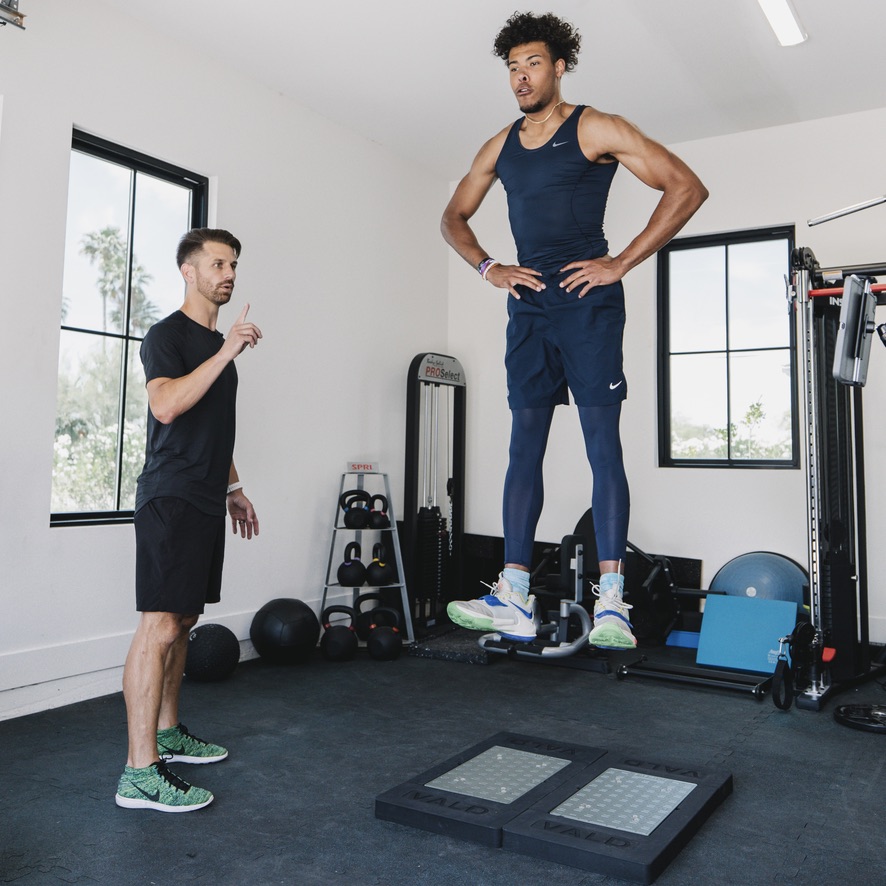
Forwards and centers, by contrast, thrive when propulsive metrics shine. High propulsive impulse and power translate into stronger drives through contact, more explosive second jumps, and a greater chance of securing contested rebounds (Berberet, 2024). In soccer or volleyball, similar logic applies—athletes with higher propulsive power are better positioned for aerial duels and quick vertical demands.
When CMJ data is embedded into broader profiling—alongside sprint times, change-of-direction tests, and positional demands—it becomes a predictive tool. Not only can it flag readiness by highlighting neuromuscular fatigue, but it can also illuminate risk by revealing declining eccentric braking qualities or asymmetry creeping upward. In this way, CMJ metrics evolve from numbers on a report to actionable insights guiding training, recovery, and long-term athlete development.
- Overemphasizing jump height alone.
- Collecting too many metrics without context (“data drowning”).
- Ignoring variability—metrics like asymmetry have high coefficient of variation and must be interpreted cautiously (Berberet, 2024).
Integration with the 3P Framework
The 3P Framework—Principles, Process, and Plans— is my model for bridging rehab, performance training, and sports science. At its core, it ensures decision-making is consistent, evidence-based, and tailored to the athlete in front of you.
- Principles: Train both output and strategy metrics; avoid single-variable bias.
- Process: Use embedded testing—weekly CMJs as readiness markers.
- Plans: Adjust training stress (load, velocity, density) based on CMJ responses, embedding them into the 3P Injury Prevention Toolkit.
In the context of CMJ testing, the 3P Framework ensures that practitioners not only collect force plate data, but also interpret it through sound principles, apply it consistently in process, and execute plans that keep athletes progressing while minimizing injury risk.
Summary & Takeaways
CMJ force plate testing is powerful when practitioners focus on the right metrics and tie them back to training interventions. The art lies not in collecting data, but in translating it into actionable plans—whether that’s improving RSI-mod for basketball guards or eccentric braking force for ACL rehab.
- Always contextualize within athlete profiling and sport demands.
- Choose fewer, meaningful metrics (jump height, RSI-mod, braking impulse).
- Train eccentric strength for braking metrics.
- Train concentric power for propulsive metrics.
- Use strategy drills to refine neuromuscular efficiency.
Free Download
Watch More Like This
Read More Like This
Related Podcasts
References
Berberet D, Petway A, Bell K, et al. Unlocking Basketball Athletic Performance: Force Plate-Derived Countermovement Jump Normative Reference Values. Int J Strength Cond. 2024.
Bishop C, Turner A, Jordan M, et al. A Framework to Guide Practitioners for Selecting Metrics During the Countermovement and Drop Jump Tests. Strength Cond J. 2021.
Weakley J, Mann B, Banyard H, et al. Velocity-Based Training: From Theory to Practice. Strength Cond J. 2020
